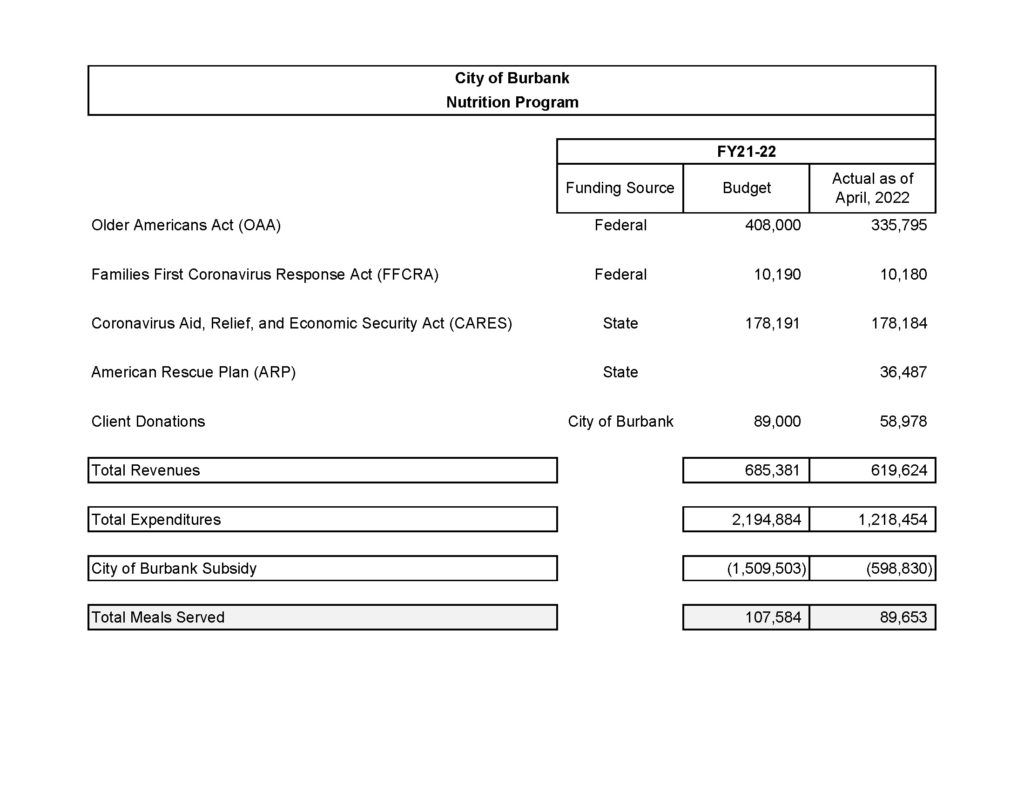A thorough analysis of the nutrition subsidies and programs available to low-income seniors in California reveals several existing resources that can potentially make local programs like the one in Burbank redundant. These programs offer comprehensive support to seniors, ensuring that their nutritional needs are met without the need for additional city expenditure.
The Burbank Senior Nutrition Program costs $2.2 million annually.
Existing Nutrition Programs for Low-Income Seniors in California
- CalFresh (formerly known as Food Stamps)
- Description: CalFresh provides monthly food benefits to low-income individuals and families. Seniors can use these benefits to purchase food at grocery stores, farmers’ markets, and other approved retailers.
- Eligibility: Low-income seniors must meet income and residency requirements to qualify. The program specifically considers the needs of elderly and disabled individuals.
- Supplemental Nutrition Assistance Program (SNAP)
- Description: As a federally funded program, SNAP assists low-income seniors by providing funds to buy groceries. Benefits are distributed via an Electronic Benefit Transfer (EBT) card.
- Eligibility: Similar to CalFresh, with income thresholds and asset limits tailored to accommodate seniors and the disabled.
- Commodity Supplemental Food Program (CSFP)
- Description: This program offers monthly food packages to low-income seniors aged 60 and above. The packages include a variety of nutritious foods designed to supplement the diets of participants.
- Eligibility: Seniors must meet income guidelines to qualify for the program.
- Meals on Wheels
- Description: Meals on Wheels delivers nutritious meals directly to the homes of seniors who are unable to prepare their own meals or travel to meal sites. The program also provides social interaction and safety checks.
- Eligibility: While primarily focused on homebound seniors, eligibility criteria include low-income status and the need for meal delivery due to physical or mobility issues.
- Senior Farmers’ Market Nutrition Program (SFMNP)
- Description: SFMNP provides low-income seniors with coupons that can be used to purchase fresh fruits, vegetables, honey, and herbs at farmers’ markets and roadside stands.
- Eligibility: Seniors must meet age and income requirements to participate.
- Congregate Nutrition Services (Title III-C of the Older Americans Act)
- Description: These services offer nutritious meals at group sites such as senior centers, community centers, and faith-based facilities. In addition to meals, the program provides opportunities for social engagement and wellness activities.
- Eligibility: Open to seniors aged 60 and older, particularly those with economic or social needs.
- Home-Delivered Nutrition Services (Title III-C of the Older Americans Act)
- Description: This service delivers meals to homebound seniors who are unable to prepare their own meals or travel to meal sites.
- Eligibility: Designed for seniors aged 60 and older who are homebound and meet the program’s nutritional risk criteria.
Salary Range Analysis for City Employees Managing the Senior Nutrition Program
To estimate the salary ranges for city employees who could potentially manage the senior nutrition program, a review of the City’s salary listings was conducted. Key roles likely involved in such program management include Program Managers, Administrative Analysts, Account Clerks, Coordinators, and Officers. The monthly salary ranges for these roles are as follows:
- Program Managers:
- Monthly Salary Range: $8,287.76 to $13,863.01
- Administrative Analysts:
- Monthly Salary Range: $5,054.79 to $8,531.71
- Account Clerks:
- Monthly Salary Range: $3,814.01 to $4,533.66
- Coordinators:
- Monthly Salary Range: $4,735.79 to $5,358.10
- Officers:
- Monthly Salary Range: $8,332.18 to $9,904.35
Challenges in Tracking Labor Costs
In the City of Burbank, the staff forms a tight-knit group, often leading to overlapping responsibilities and shared workloads across various projects. This dynamic complicates the accurate tracking of labor costs and specific contributions to individual programs like the senior nutrition program. Employees are frequently borrowed from different departments to meet project demands, making it difficult to allocate labor costs precisely.
Despite efforts to account for labor accurately, the fluid nature of municipal operations means roles and responsibilities shift based on immediate needs. This flexibility can obscure the true costs associated with specific programs, making it challenging for taxpayers to understand the full financial burden of managing initiatives like the senior nutrition program. This highlights the need for transparency and accountability in evaluating the cost-effectiveness of municipal programs versus leveraging existing nonprofit resources.
Summary of Burbank Nonprofits
Burbank is home to a total of 656 nonprofit organizations. Among these, 259 are currently active, as indicated by their Form 990 filings. The total assets held by these nonprofits amount to $1,763,860,179, while their combined total revenue is $1,642,964,474.
Analysis and Recommendation
We conducted interviews. One of the seniors in Burbank who receives services from the senior nutrition program shared her experience with us. She revealed that she gives away the food to a neighbor because she doesn’t like the types of food she receives. Despite not using the service herself, she keeps receiving it to help someone else who is not a senior. This situation highlights the potential for abuse of the program, as it appears there isn’t an efficient auditing system to ensure the proper use of resources. This misuse raises concerns about the increasing tax burden on all residents due to inefficient oversight.
With a significant number of nonprofit organizations headquartered in the City of Burbank, it is worth questioning why taxpayers are being asked to fund the city’s senior nutrition programs, which currently cost more than $2,194,884 annually. Given the substantial assets and revenues managed by these nonprofits, it would be more efficient and beneficial to transition the responsibility of senior nutrition programs to these organizations. This shift would alleviate the financial burden on taxpayers and allow nonprofits to better assess and address the true needs of seniors, ensuring that resources are utilized effectively and reaching those who genuinely need assistance.



